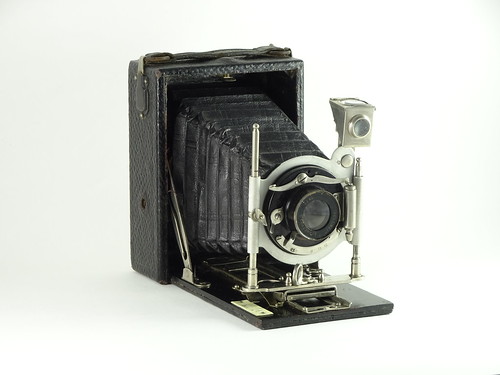Difference between revisions of "Ensign Klito Nos. 0 and 00"
(Klito No.0 page created) |
Hanskerensky (talk | contribs) (Added Category:Quarter plate) |
||
| (5 intermediate revisions by 2 users not shown) | |||
| Line 1: | Line 1: | ||
| − | |||
{{Flickr_image | {{Flickr_image | ||
| − | |image_source= | + | |image_source= https://www.flickr.com/photos/99085049@N05/47745338382/in/pool-camerawiki/ |
| − | |image= | + | |image= https://live.staticflickr.com/65535/47745338382_a87a6d723c.jpg |
|image_align= right | |image_align= right | ||
| − | |image_text= Ensign Klito | + | |image_text= Houghton Ensign The Folding Klito |
| − | |image_by= | + | |image_by= Jacques Bratieres |
| − | |image_rights= with permission | + | |image_rights= with permission |
}} | }} | ||
| + | [[Ensign]]'s '''Folding Klito Nos. 0 & 00''' are a vertical folding bed cameras for the quarter-plate format. | ||
| + | |||
| + | The camera body is constructed from wood, the folding bed being made from aluminium, with external leather covering and bellows, and measures approximately 140 x 110 x 50mm when closed. It has single-extension bellows and front rise. As well as ground glass focus, there is a [[brilliant finder]] with spirit level and a focus scale on the drop bed with a click-stop for infinity when erecting the front standard. | ||
| + | |||
| + | The Folding Klito No.0 was supplied with a Rapid Achromatic lens. In ascending order of expense, lenses provided for the Klito No.00<ref>''The "Ensign" Handbook of Photography'', retrieved from: http://www.butkus.org/chinon/ensign/ensign_handbook/ensign_handbook.htm</ref> were: | ||
| + | |||
| + | *Rectimat Symmetrical f6.8 | ||
| + | *Ensign Anastigmat f7.7 | ||
| + | *Ensign Anastigmat f6 | ||
| + | *[[Aldis]] Plano Anastigmat f6.8 | ||
| + | *Zeiss Triotar Anastigmat f6.3 | ||
| + | |||
| + | Lenses were set in an Ensign Simplex-Auto shutter with speeds of 1/25th, 1/50th, 1/100th, T and B. | ||
| + | |||
| + | ==Notes== | ||
| − | + | <references /> | |
| − | |||
| − | [[Category:Ensign]] | + | [[Category:Ensign|Klito No.0]] |
| + | [[Category:K|Klito No.0 Ensign]] | ||
| + | [[Category:Quarter plate]] | ||
Latest revision as of 06:33, 8 January 2023

|
| Houghton Ensign The Folding Klito image by Jacques Bratieres (Image rights) |
Ensign's Folding Klito Nos. 0 & 00 are a vertical folding bed cameras for the quarter-plate format.
The camera body is constructed from wood, the folding bed being made from aluminium, with external leather covering and bellows, and measures approximately 140 x 110 x 50mm when closed. It has single-extension bellows and front rise. As well as ground glass focus, there is a brilliant finder with spirit level and a focus scale on the drop bed with a click-stop for infinity when erecting the front standard.
The Folding Klito No.0 was supplied with a Rapid Achromatic lens. In ascending order of expense, lenses provided for the Klito No.00[1] were:
- Rectimat Symmetrical f6.8
- Ensign Anastigmat f7.7
- Ensign Anastigmat f6
- Aldis Plano Anastigmat f6.8
- Zeiss Triotar Anastigmat f6.3
Lenses were set in an Ensign Simplex-Auto shutter with speeds of 1/25th, 1/50th, 1/100th, T and B.
Notes
- ↑ The "Ensign" Handbook of Photography, retrieved from: http://www.butkus.org/chinon/ensign/ensign_handbook/ensign_handbook.htm